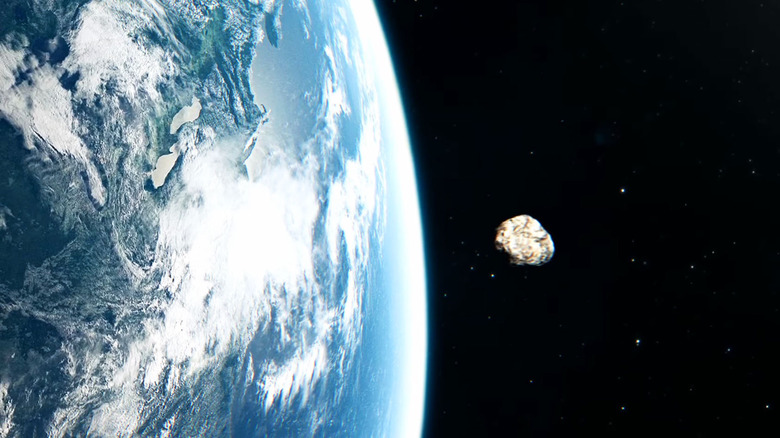How Prepared Is Earth For An Asteroid Collision? Here's What We Know
While rumors swirl about the asteroid Apophis smashing into Earth and ending all life as we know it are not very comforting, the truth is that scientists currently don't believe that there's a high likelihood of an apocalyptic cataclysmic event from an asteroid or meteorite any time soon. While initial theories in 2004 believed that the asteroid would collide with Earth in 2029, later calculations concluded there's no risk of Apophis, or any large asteroid, colliding with our planet for at least the next 100 years.
That being said, not all asteroids in our galaxy have been documented or located, leaving the door open for a yet-undiscovered threat in the form of a flying space rock. This was the case on February 15, 2013, when a 66-foot-wide meteor exploded over Chelyabinsk, Russia, causing a shockwave that injured at least 1,500 people and damaged 7,200 buildings in the area. As a response, U.S. politicians called upon NASA to develop solutions against the potential threat of a meteorite smashing into Earth and causing widespread destruction.
Toward this effort, NASA made up a team known as the Planetary Defense Coordination Office (PDCO), which seeks to identify asteroids and comets passing near Earth's orbit and is currently developing systems to prevent catastrophic impacts with Earth. So far, the program has been highly successful, with the organization presenting new findings as recently as March of 2023 for a mission to deflect an asteroid with a device launched from Earth.
The DART defense system was successful in 2022
On September 26, 2022, the Double Asteroid Redirection Test, or DART, successfully smashed into a non-Earth-threatening asteroid named Dimorphos after a 10-month journey. Success in this case was determined by NASA scientists, who measured changes in the asteroid's orbit around an even larger asteroid called Didymos.
Dimorphos measures around 525 feet in diameter, big enough to cause catastrophic devastation to Earth if it impacted a populated area. To put it into perspective, the 12-megaton explosion known as the Tunguska Event, which flattened more than 830 square miles of forest, was believed to be caused by a meteorite of only 160 to 200 feet in size.
The mission was considered a success if DART could reduce the asteroid's orbit around Didymos by at least 73 seconds. Surprisingly, the mission exceeded that goal, reducing the orbit of the asteroid by a whopping 33 minutes. The program's success demonstrated that future asteroids of this size could easily be re-directed by a similar instrument.
Asteroids impact Earth all the time
The interesting truth is that meteorites hit the planet more often than you'd think and are often not dangerous to humans. According to NASA's Center for Near Earth Object Studies, over 950 fireballs (exceptionally bright meteors) have been recorded since 1988, many of which made it to Earth with little to no human issue. Most will burn up in the atmosphere, with others becoming so small upon eventual impact that no one even notices it.
It's important to point out that 70% of the Earth is covered in water, with a minuscule relative area inhabited by humans, making the likelihood of an impact affecting human life low in comparison. Secondly, the immediate effects of an asteroid impact are often not even their most dangerous aspect; it's the downwind and long-term effects, like tsunamis or the impact that shockwaves have on soil, crops, and water reservoirs.
Knowledge is power when it comes to deflecting asteroids
The success of DART or any other asteroid defense system greatly hinges on our ability to predict future asteroid impacts with a high degree of certainty. This is an area in which astronomers are somewhat lagging due to the vast number of asteroids in our solar system. It's estimated that the DART program would need somewhere between 7 and 10 years of advanced notice, which would mean identifying and tracking an asteroid well in advance.
According to the European Space Agency, the organization has discovered 30,039 near-Earth asteroids in the Solar System, with most of the discoveries coming within the last decade. However, "near-Earth asteroid" may be somewhat of a misnomer, as many of these objects are a far way off from actually colliding with the planet.
As of the end of 2022, only 1,425 asteroids have a non-zero chance of impact, all of which have less than a 1% chance of actually hitting Earth. Today, even amateur astronomers are helping NASA and other space organizations worldwide identify new asteroids fairly frequently.
There are other solutions that may never be tested
Before the success of the DART mission, several theoretical solutions were thrown around about how to handle a significant asteroid impact on Earth. These ideas include laser ablation, where a high-powered laser would be shot at the asteroid to release gas and change its trajectory. Another idea to destroy earth-threatening asteroids was nuclear weapons, much like in the movie "Armageddon."
However, because NASA's DART mission proved to be successful, it's unlikely that other methods of asteroid deflection will be tested anytime soon, as the team's theories on kinetic impact proved to be effective. The results of this can't be understated, as humanity now has a proven tool against potential asteroids that may threaten Earth.
Ultimately, and perhaps surprisingly, humanity is fairly prepared for an asteroid collision. Governments worldwide have acknowledged the threat of a potential asteroid impact, and leading scientific organizations like NASA have invested time and resources in developing solutions within the last decade. While a new asteroid set on a collision course with Earth may be discovered, for the first time in human history, we can say that we have a real solution to the problem.




